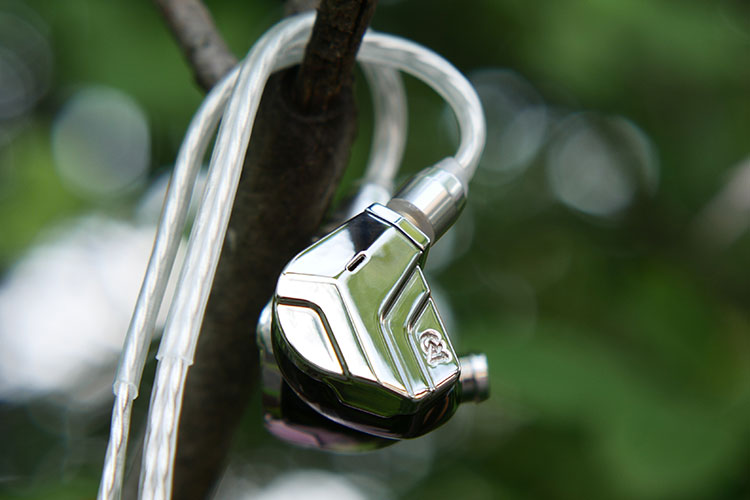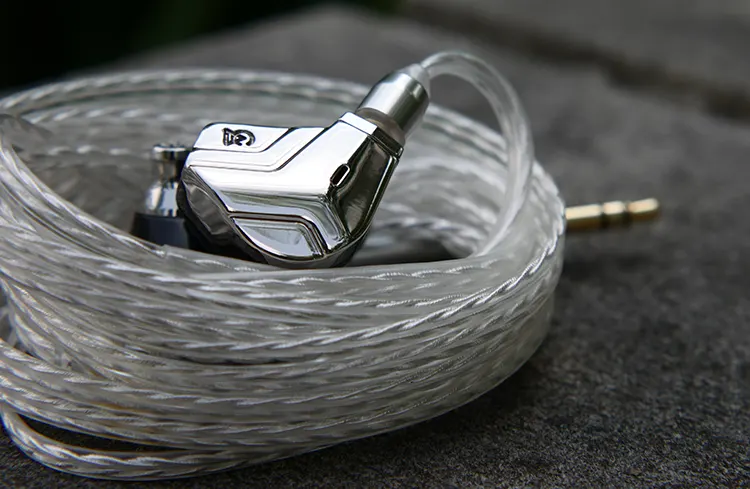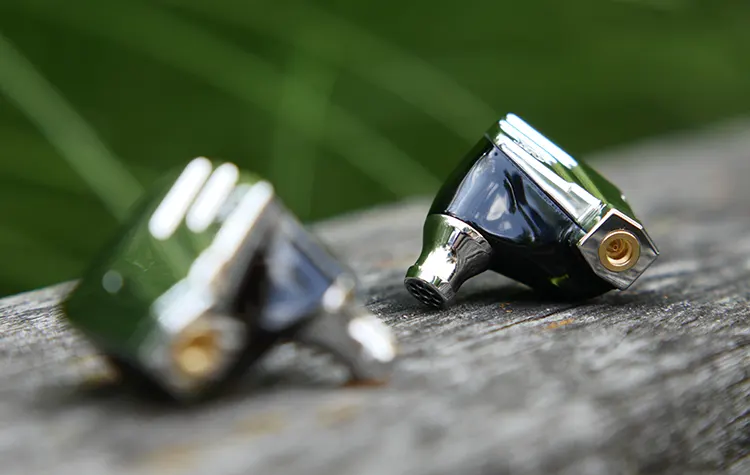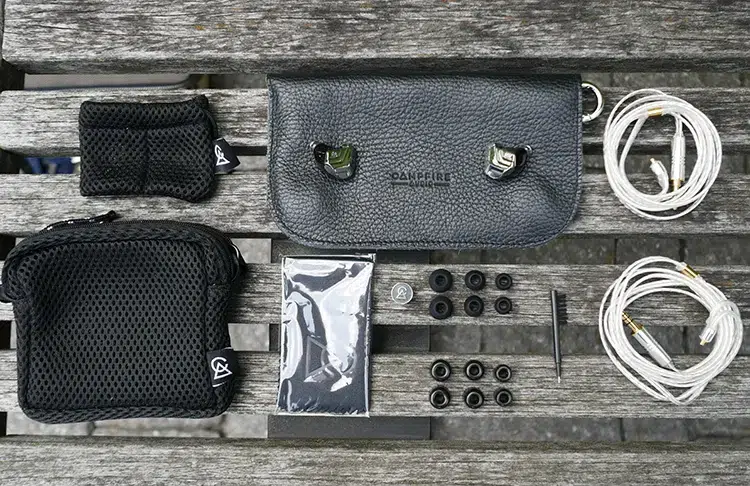Today, Thomas reviews the Campfire Audio Astrolith, which is a new high-end dual planar magnetic driver universal in-ear monitor priced at $2199. It is due for release on August 6th, 2024.
Disclaimer: This sample unit was sent to me in exchange for our honest opinion. Headfonics is an independent website with no affiliate links or services. I thank the team at Campfire Audio for their support.
Click here to read more about Campfire Audio products we previously reviewed on Headfonics.
Note that this article follows our current scoring guidelines which you can read in more detail here.
The Campfire Audio Astrolith is the company’s third foray into planar magnetic driver IEMs and can be considered their TOTL version priced at $2199.
Their previous planar models, the Supermoon and Moon Rover, contained only one driver per side, while the Astrolith doubles this count to 2 with a large 14.2mm combined with a new, smaller 6mm version.
In addition, the Astrolith debuts a new shell design with a bold look and outstanding ergonomics that rival the best the brand has developed so far.
With an impressive spec sheet, promising technology, and an exciting new shell design, the Astrolith gives premium earphone buyers an enticing new product to sink their ears into.
Features
Inside the Astrolith is a twin planar-magnetic driver setup. A custom 6mm planar tweeter is combined with a considerably larger 14.2mm planar that handles the sub-bass to midrange frequencies, to provide a fully fleshed-out signature with excellent extension at either end.
The surrounding universal shell design is a hybrid of different materials and technology. A machined, stainless-steel faceplate is polished to a mirror finish and married to a highly ergonomic 3D-printed acrylic base.
This shell features a new technology named Additive Acoustic Optical Inclusion (AAOI) where engineered chambers control acoustic volumes. This enables the precise tuning of the all-new planar magnetic drivers within the chambers.
Another new technology applied to the tweeter specifically is the Particle Phase Resonator (PPR). This uses tailored geometry within the housing to phase and frequency correct the tweeter’s output.
Campfire Audio’s iconically durable beryllium-copper MMCX ports make a return for the Astrolith. They are the best version of this tech with thick sidewalls that will help ensure their longevity.
Another welcome feature of the Astrolith is the two upgraded Time Stream Metal cables. One is terminated in a single-ended 3.5mm plug, while the other lets you go balanced via a 4.4mm plug.
Design
Where Campfire Audio’s recent release, the Moon Rover, featured their classic angular shell, the Astrolith features an all-new design, though one that uses materials and technology Campfire Audio has been refining over the years.
Immediately grabbing your attention is the bold stainless-steel faceplate. The surface has been polished to a mirror finish and has an angular, 70’s-space-age look that reflects the aesthetics laid out by the impressive packaging design.
The rear half of the shell is 3D-printed acrylic with a shape reminiscent of their classic shell design but with all the defined edges rounded and smoothed. A polished stainless-steel nozzle, with a 6mm diameter at its widest, rounds out the visually appealing shells of the Astrolith.
The only complaint I can aim at the shell is how easily it picks up and shows fingerprints and smears. I also worry about the steel faceplates scratching, but I have carefully avoided this by using the Breezy Bag Micro whenever the earphones are not in use.
Campfire Audio’s reliable beryllium-copper MMCX ports are neatly integrated into the upper stalk of the shell. The Astrolith uses my favorite version of this port, with extra thick sidewalls, suggesting they will provide a solid, interruption-free connection for years.
One aspect of the shell that will be easily overlooked is the translucent nature of the acrylic. Hold it up to a strong light source, and you can see the textured internal structure supporting the large planar, along with the sound channels leading to the nozzle.
A special edition of this model utilizing a more transparent acrylic exterior with unique designs and coloration incorporated into the internal latticework would be amazing.
This new design would allow for innovative and unique possibilities for special and limited-edition models, unlike anything Campfire Audio has crafted before.
Comfort & Isolation
While not small, the Astrolith is lightweight with a smooth inner half that feels exceptional in the ear. Weight is distributed evenly around the outer ear and the nozzle angle feels natural, resulting in Campfire Audio’s most comfortable and ergonomic shell to date.
This is an earphone I can wear for hours upon hours without needing to take a break due to fatigue or hotspots as it sits so naturally in the ear and is completely absent of sharp edges or odd protrusions.
Stability isn’t as impressive as those models in the custom-inspired Chromatic Series, but the cable-up design and chin cinch ensure the Astrolith isn’t far off needing only the occasional reseating to regain a good seal.
Passive isolation of the Astrolith is about average. The insertion depth isn’t extreme, the shell doesn’t fill the features of the outer ear, and there is a single vent on the faceplate, all of which contribute to some outside noise bleeding in.
That said, taking the Astrolith into a noisy environment like a busy coffee shop is still a good experience. Only a small increase in volume is needed to block incoming noise and continue listening at a safe and comfortable level.
If foam tips are your jam, Campfire’s included Mushroom foamies do a great job and ensure the Astrolith can remain a versatile daily driver in chaotic environments.
Ear Tips
The Astrolith was not greatly affected by the different tips I tested, so I made my choices based on fit consistency, comfort, and isolation.
The stock wide bore set failed to provide a reliable seal thanks to their low seating on the nozzle. Sennheiser’s shallow bi-flange provided a fantastic seal and improved isolation, so they were the best wide-bore alternative, even if they got itchy after half an hour or so.
CP120 and CP145 from SpinFit were fantastic options for a deeper fit, though I found they dropped the seal more often than I’d like, so maybe go up a size if you’re trying these out. If you prefer or require a deeper inserting tip, these should do the trick since they’re comfortable and fit the nozzles well.
My favorites for comfort were Sony Hybrids. The soft silicone and reliable seal paired with the Astrolith’s superb comfort levels perfectly, and as such I listened with these in place most of the time.
ADV’s Eartune Fidelity U tips provided a similar experience to the Sony Hybrids but were the only tip where major differences were obvious.
I found the upper mids and treble fatiguing at normal listening levels, so it might be best to avoid pairing these with the Astrolith unless you feel it lacks energy in these regions.
While I typically avoid foam tips for comfort issues, the included set pairs very well with the Astrolith. In addition to improving isolation and providing the most reliable seal of the group, they smoothed the signature ever so slightly and added warmth and weight to the midrange.
While some tips tested affected the Astrolith’s signature, the changes were generally mild. This is one earphone where I’d recommend using a tip that is either the most comfortable, or best isolating.
Stock Cables
Introduced with their Chromatic lineup of earphones, the Astrolith comes with not one, but two Time Stream cables, and not the base version either. Both are from the upgraded Metal series which upgrades the hardware with you guessed it, metal components.
One cable features a standard single-ended 3.5mm plug while the other provides a balanced option via a durable 4.4mm plug. Enameled silver-plated copper wires with 8 conductors per strand can be found within the non-migratory PVC jacket.
The jack, y-split, and MMCX connectors are compact metal units that add a more premium look and feel to the Time Stream series.
The silver-colored jack has cleanly cut ridges which add grip, the golden y-split has the CA logo neatly etched, and the MMCX plugs are tiny with L and R markings that are challenging to see in low light.
Sitting just above the y-split is a slender, neatly hidden chin cinch which does a fantastic job of staying where you place it. While microphonics are already extremely low on these cables, the cinch further reduces it.
The Time Stream cables utilize preformed ear guides. The standard versions I tested with the Cascara and Ponderosa could be noisy during movement, something I have not experienced with the enhanced Metal versions.
While I usually dock points for missing strain relief, the flat, wide, quad-strand, ribbon-style design is tough enough as-is and provides passive support against bends. Memory of kinks and tight bends is almost non-existent, nor is tangling an issue.
Packaging & Accessories
Campfire’s packaging does not follow industry trends, and the package for the Astrolith is no exception. I can comfortably say the 70’s sci-fi-inspired design is my favorite of everything I’ve reviewed in the last decade, it’s that unique and interesting.
The top is dominated by an image of a man overlooking a terraformed moon or planetoid with sprawling terraced fields surrounding a majestic city.
In the sky is what looks to be a terrestrial planet with vast oceans, not unlike Earth, protected by a gridded dome with celestial bodies dotting the encircling space.
The purple writing and vibrant chartreuse coloring are both alien and familiar, evoking thoughts of wonderment and discovery. It is a magnificent sight that carries on around the rest of the package, inside and out.
Along with the stunning visuals you find plenty of useful information about the Astrolith throughout the various sections of the box.
Specifications, design highlights, warranty information, fitting instructions, and more are all conveyed without additional printed material that would likely end up in a landfill or recycling bin.
Included are:
- Astrolith earphones
- Time Stream Metal cable with 3.5mm single-ended termination
- Time Stream Metal cable with 4.4mm balanced termination
- Hand-crafted premium leather case
- Marshmallow foam tips s/m/l
- Wide bore silicone tips s/m/l
- Campfire Audio Pin
- Microfiber cloth
- Cleaning tool
- Champagne Breezy Bag
- Champagne Breezy Bag Micro
**While our images show black Breezy Bags, retail copies of this earphone will include champagne-colored Breezy Bags. **
This is an excellent accessory package, the lack of tip variety being the only negative. The leather case feels very premium, two cables in single-ended and balanced configurations are welcome, and the various cases and bags ensure everything is contained and protected.
Click on page 2 below for my sound impressions and recommended pairings.








